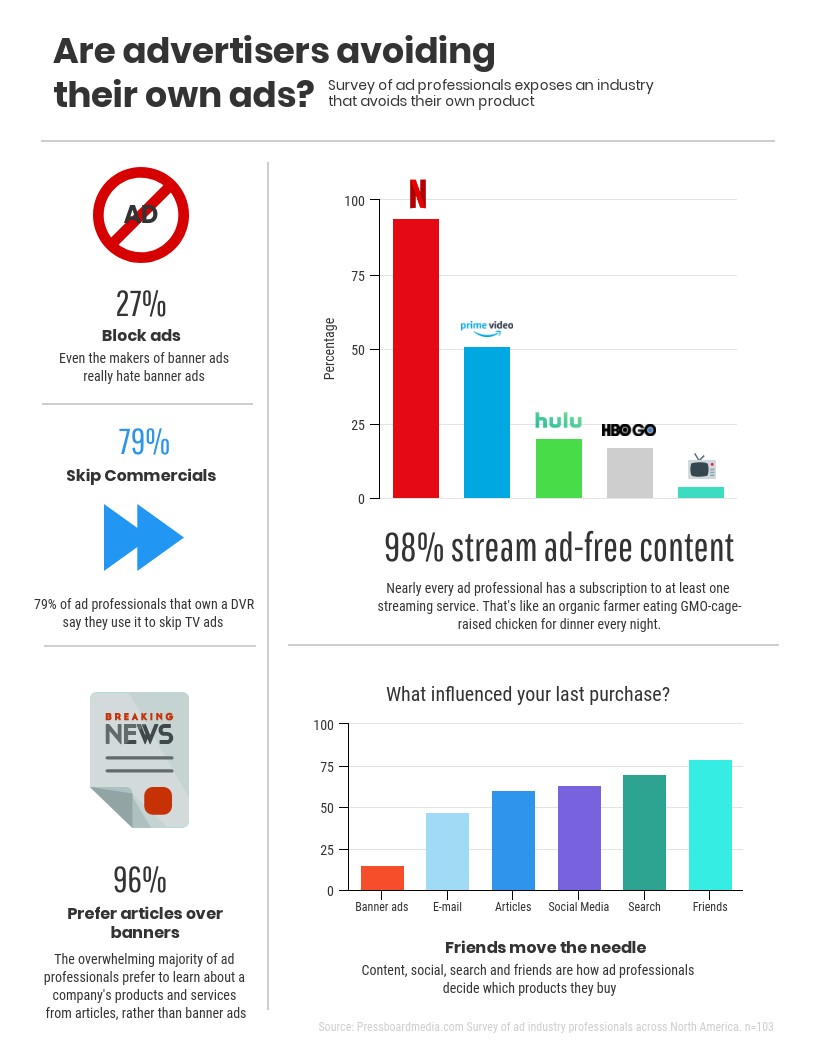 When’s the last time you skipped an ad on YouTube or fast-forwarded past a commercial on your DVR? There’s no shame in admitting it—even if you’re a marketer who eats, sleeps, and breathes advertising in your day job.
When’s the last time you skipped an ad on YouTube or fast-forwarded past a commercial on your DVR? There’s no shame in admitting it—even if you’re a marketer who eats, sleeps, and breathes advertising in your day job.
In fact, Pressboard recently conducted a survey that found that advertisers, of all people, are just as averse to ads as anyone else. 98% stream ad-free content on platforms like Netflix or Prime Video, for example, and 79% own a DVR they use to skip commercials.
We might just be the only industry that actively avoids the product we make. You’d be hard-pressed to find a dentist who doesn’t floss or an organic farmer who opts for caged, GMO chickens over free-range, non-GMO chickens.
Read More: The Dawn of the Platform Age: Digital Marketing Maturity at Last?
I’m no exception. Even though I run an ad-tech company, I use an ad blocker and a DVR, and I subscribe to 3 different streaming services that let me watch TV commercial-free.

Read More: What Does Original Content Mean?
Yet at the same time, I eat ads alive—sharing viral Super Bowl commercials with friends, listening to branded podcasts, and getting in line for product taste tests at the grocery store.
It’s not that I want to avoid brands. I just want to be given information and experiences that I’m interested in, and unfortunately, 99% of ads right now don’t fall into that category.
What gives?
For starters, we need to be honest: some ads suck. Being bombarded with hundreds each day sucks even more. The sorry state of display ads today means that you’re more likely to survive a plane crash than have someone click on your banner ad.
Read More: Resolving the Ecommerce Identity Crisis
Now, don’t panic. Advertising isn’t dead. We just might want to think about doing it differently—and that means rethinking things that worked in the past.
Take Gen Z (born between the years 1995 and 2010), for instance. They’re the toughest age group to market to, with 69% actively avoiding ads and skipping ad videos three seconds earlier than Gen X. But they aren’t impossible to reach, either.
Kantar Millward Brown’s AdReaction: Engaging Gen X, Y, and Z study suggests that getting creative with ads, not making advertising unavoidable, is key to engaging with this hard-to-reach demographic. He hints that music, a strong design aesthetic, humor, and videos less than 10 seconds long are more likely to get Gen Z’s attention.
Read More: Have We Lost Sight of Viewability?
As for advertisers themselves, their purchase decisions are most affected by emails, articles, web searches, and friends’ recommendations—not banner ads alone. In fact, as per the survey, fewer than 25% cite banner ads as influencing their latest purchase. These are all media, more or less, that can be mined for prime marketing territory—ones that won’t send your audience running, either.
The takeaway? Advertising still works—we just have to do it differently.
In a time when even ad-makers are rejecting traditional forms of advertising, content marketing is a proved and promising way to engage with audiences of all ages. Our survey showed that 96% of advertisers would rather learn about a company’s products and services through reading an article than seeing a banner ad. Plus, native ads have a click-through rate three times higher than old-fashioned display ads.
Most of us get our marketing inspiration from the world’s best advertising copy and campaigns. It might be time to clue into what’s getting on our nerves, too. What it all comes down to is keying in on what makes you turn up your nose at some ads—and making your own better.
After all, if we don’t want to consume our own ads, who else will?
Read More: A Beginners Guide to Positioning a Strong Online Brand











